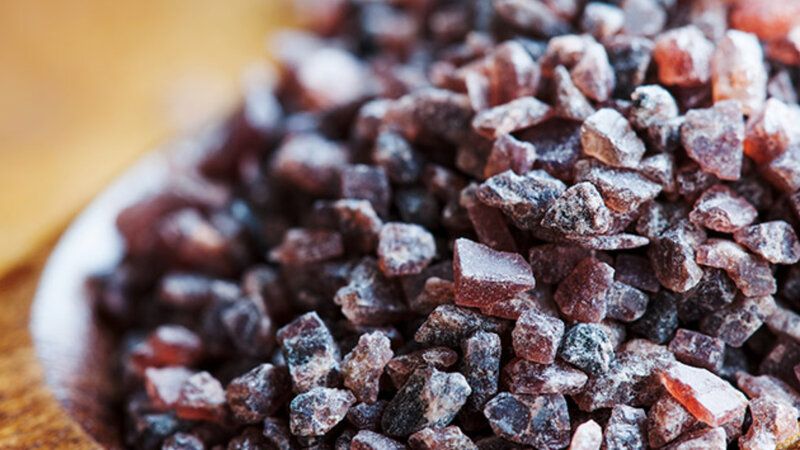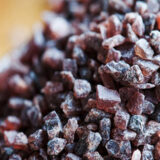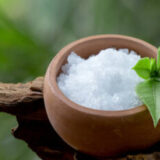Kala Namak : The Black Salt With Health Benefits and Unique Flavors
The culinary world is a treasure trove of diverse spices and condiments that bestow unique flavors upon a myriad of dishes. Among these intriguing ingredients stands “Kala Namak” or Black Salt. 
With its origins rooted in the Indian subcontinent, Kala Namak has been cherished for centuries not only as a culinary enhancer but also for its potential health benefits.
In this article, we embark on a journey to explore the fascinating origins, distinctive properties, culinary applications, and health advantages that Kala Namak brings to the table.
What is Kala Namak?
Kala Namak, also known as Sanchal or Black Salt, is a type of rock salt with a distinct color and flavor. It is mainly found in the Himalayan regions of India, Pakistan, and Nepal. The salt gets its unique black color due to the presence of trace minerals and iron compounds, which also impart a characteristic sulfuric aroma to it.
The History of Kala Namak
The origins of Kala Namak are deeply rooted in history, with a rich and fascinating background. This unique salt has been an integral part of traditional Ayurvedic medicine for centuries, esteemed for its medicinal properties. Initially sourced from volcanic mines nestled in the Himalayas, Kala Namak has held a significant place in culinary and medicinal practices since ancient times.
Exploring Black Salt: Composition, Price, Production, and Uses
Black salt, also known as Kala Namak, is a unique and flavorful condiment that has captured the attention of culinary enthusiasts and health-conscious individuals alike.
In this section, we will delve into various aspects of black salt, including its composition, price, manufacturing process, health benefits, chemical name, comparison with rock salt, common uses, and its versatility in the culinary world.
Black Salt Composition
Black salt primarily consists of sodium chloride, like regular table salt, but it also contains additional minerals and compounds that give it its distinctive color and flavor. Notably, it contains small amounts of iron sulfide, which contributes to its characteristic sulfuric aroma.
Black Salt Price
The price of black salt can vary based on its origin, quality, and packaging. Generally, it is slightly more expensive than regular table salt due to its unique properties and regional availability.
How Black Salt is Made?
The process of making black salt, also known as Kala Namak, involves a traditional and intricate method. Here’s how this unique condiment is crafted:
1. Raw Salt Selection: The process begins with carefully selecting raw salt, which serves as the base for black salt production. High-quality raw salt ensures a superior final product.
2. Heating with Herbs and Spices: The raw salt is heated at high temperatures in a controlled environment. During this stage, specific herbs and spices are added to the mix, including harad seeds, amla, and cardamom. These additives play a crucial role in giving black salt its distinctive flavor and aroma.
3. Cooling and Grinding: After the heating process, the mixture is allowed to cool down. Once cooled, the blend is finely ground to achieve the desired texture and consistency.
4. Final Processing: The ground mixture undergoes additional processing steps to ensure its quality and purity. It is carefully inspected, and any impurities are removed, leaving behind a refined black salt ready for consumption.
By following this age-old process, artisans produce the exquisite and flavorful black salt that has been cherished for generations in culinary and medicinal practices.
Black Salt Chemical Name
The chemical name for black salt is “sodium chloride with iron sulfide.”
Black Salt vs. Rock Salt
While black salt and rock salt (or pink Himalayan salt) are both variants of salt, they have distinct differences. Black salt has a distinctive sulfuric flavor, while rock salt has a milder taste. Black salt is typically used as a flavor enhancer and vegan egg substitute, whereas rock salt is commonly used for cooking, curing, and preserving food.
Black Salt Formula
The chemical formula of black salt is NaCl (sodium chloride) with traces of FeS (iron sulfide).
What is Black Salt Used For?
Black salt finds a variety of uses in the culinary world. It is a popular ingredient in Indian chaats, chutneys, and spice blends. Moreover, its unique flavor makes it a key component in vegan cuisine, where it is used to mimic the taste of eggs in dishes like vegan omelets and tofu scrambles. Additionally, black salt can be sprinkled on fruits and salads to add an intriguing twist to their taste.
In conclusion, black salt, or Kala Namak, is a distinctive condiment with a rich history and an array of culinary and health benefits. From its unique composition to its versatile uses in the kitchen, black salt continues to captivate taste buds and health-conscious individuals worldwide.
Culinary Uses of Kala Namak
1. Enhancing Flavor in Chaats and Chutneys
Adding a burst of flavor to Indian chaats and chutneys, Kala Namak is a favored ingredient. A mere pinch of this salt is enough to enhance the taste of these dishes, infusing them with a distinctive tanginess that delights the palate.
2. Vegan Egg Substitute
Kala Namak finds an intriguing use in vegan cuisine as a remarkable egg substitute. Whether in delectable vegan omelets or savory tofu scrambles, its distinctive sulfuric taste mirrors the flavor of eggs, making it a popular choice for those seeking plant-based alternatives in their meals.
3. Flavoring Fruits and Salads
Kala Namak adds a delightful touch to various fruits and salads. By sprinkling this unique salt on fruits like raw mangoes and pineapples, a perfect balance of sweetness and savory goodness is achieved. Additionally, it serves as an excellent flavor enhancer for salads, providing that extra layer of taste to elevate the overall dining experience.
Himalayan Black Salt Benefits
Himalayan black salt is particularly valued for its potential health benefits. It is believed to aid digestion, alleviate gas and bloating, and promote overall digestive wellness. Additionally, its mineral-rich content offers essential nutrients like iron and potassium.
1. Digestion
Kala Namak is renowned for its digestive benefits, offering relief from gas, bloating, and indigestion. As a natural remedy, it comes highly recommended for individuals seeking to improve their digestive health, making it a valuable and flavorful addition to promoting overall wellness.
2. Mineral Content
Kala Namak’s mineral content makes it a valuable asset in maintaining a balanced diet. Abundant in essential nutrients like magnesium, potassium, and iron, this unique salt plays a crucial role in supporting overall health and well-being, making it a worthy addition to any culinary repertoire.
4. Relieving Muscle Cramps
Kala Namak’s high potassium content has led it to be favored by many as a remedy for relieving muscle cramps and spasms. Its natural ability to alleviate such discomforts makes it a popular choice among those seeking relief and relaxation. Embracing the benefits of this unique salt can help you soothe those pesky muscle twinges and unwind with ease.
5. Treating Acidity
Kala Namak is renowned for its alkaline properties, which play a crucial role in neutralizing excess stomach acid and providing relief from acidity. Including this unique salt in your diet can help in managing acidity-related discomforts, promoting a more balanced digestive experience.
Risks and Precautions
While Kala Namak offers numerous benefits, excessive consumption should be avoided, especially for individuals with hypertension. As with any dietary changes, it’s advisable to consult a healthcare professional before incorporating Kala Namak into your daily routine.
Conclusion
In conclusion, Kala Namak, the black salt with its striking color and distinctive taste, has made a mark in both the culinary and medicinal worlds. From enhancing flavors in various dishes to potential health benefits, this unique ingredient continues to captivate taste buds and intrigue health enthusiasts alike.
FAQs About Kala Namak
1. Is Kala Namak suitable for people with high blood pressure?
While Kala Namak may have certain health benefits, individuals with hypertension should consume it in moderation or avoid it altogether.
2. Can Kala Namak be used as a substitute for regular table salt?
Yes, Kala Namak can be used as a flavorful substitute for regular table salt in various dishes.
3. Does Kala Namak contain any additives?
No, authentic Kala Namak is free from additives and undergoes minimal processing.
4. Can Kala Namak be used in baking?
It is not commonly used in baking as its distinctive flavor might not complement sweet treats.
5. Is Kala Namak safe for pregnant women?
Pregnant women should exercise caution and consult their healthcare provider before adding Kala Namak to their diet.























